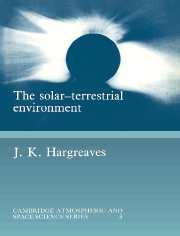 The Solar-Terrestrial Environment
The Solar-Terrestrial Environment Book contents
- Frontmatter
- Contents
- Preface
- 1 The Earth in space
- 2 The physics of geospace
- 3 Techniques for observing geospace
- 4 The neutral atmosphere
- 5 The solar wind and the magnetosphere
- 6 Principles of the ionosphere at middle and low latitudes
- 7 Ionospheric phenomena at middle and low latitudes
- 8 The ionosphere at high latitude
- 9 Magnetospheric waves
- 10 Technological application of geospace science
- Index
6 - Principles of the ionosphere at middle and low latitudes
Published online by Cambridge University Press: 29 January 2010
- Frontmatter
- Contents
- Preface
- 1 The Earth in space
- 2 The physics of geospace
- 3 Techniques for observing geospace
- 4 The neutral atmosphere
- 5 The solar wind and the magnetosphere
- 6 Principles of the ionosphere at middle and low latitudes
- 7 Ionospheric phenomena at middle and low latitudes
- 8 The ionosphere at high latitude
- 9 Magnetospheric waves
- 10 Technological application of geospace science
- Index
Summary
There are more things in heaven and earth, Horatio, than are dreamt of in your philosophy.
W. Shakespeare, Hamlet Act I Scene (v)Introduction
The ionized part of the atmosphere, the ionosphere, contains significant numbers of free electrons and positive ions. There are also some negative ions at the lower altitudes. The medium as a whole is electrically neutral, there being equal numbers of positive and negative charges within a given volume. Although the charged particles may be only a minority amongst the neutral ones they exert a great influence on the medium's electrical properties, and herein lies their importance.
The first suggestions of electrified layers within the higher levels of the terrestrial atmosphere go back to the 19th century, but interest was regenerated with Marconi's well known experiments to transmit a radio signal from Cornwall in England to Newfoundland in Canada in 1901, and with the subsequent suggestions by Kennelly and by Heaviside (independently) that, because of the Earth's curvature, the waves must have been reflected from an ionized layer. The name ionosphere was coined by R. Watson-Watt in 1926, and came into common use about 1932.
Since that time the ionosphere has been extensively studied and most of its principal features, though not all, are now fairly well understood in terms of the physical and chemical processes of the upper atmosphere. Typical vertical structures are as shown in Fig. 6.1.
- Type
- Chapter
- Information
- The Solar-Terrestrial EnvironmentAn Introduction to Geospace - the Science of the Terrestrial Upper Atmosphere, Ionosphere, and Magnetosphere, pp. 208 - 248Publisher: Cambridge University PressPrint publication year: 1992
- 2
- Cited by
